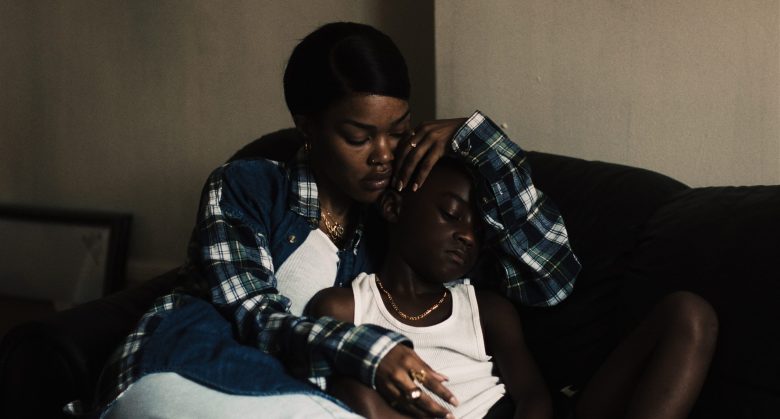“A Thousand and One” garnered rave reviews when it debuted at last year’s Sundance Film Festival, mainly for singer-turned-thespian Teyana Taylor’s revelatory lead performance. In the film, set in 1994 New York City, Taylor plays Inez, a hairdresser fresh out of prison who reunites with the young son she abandoned before her jail stint. The boy, Terry, has been trapped inside the same foster care system that ravaged her own youth, so Inez kidnaps him and tries to build a better life against the backdrop of a rapidly transforming city.
The film avoids the sensational aspects of Inez and Terry’s story. Save for some initial business surrounding the procurement of doctored papers, very little of the film’s tension comes from the “on the run” aspect of their lives. Instead, writer/director A.V. Rockwell chooses to play the long game, exploring this curious mother/son relationship across a decade. Following this dynamic provides an opportunity to interrogate the changing face of New York City, and to present the human collateral damage of gentrification.
“A Thousand and One,” named after the number on the apartment where our protagonists reside, does a remarkable job capturing a bygone era of the Big Apple.
“A Thousand and One,” named after the number on the apartment where our protagonists reside, does a remarkable job capturing a bygone era of the Big Apple. Rockwell and her cinematographer Eric K. Yue alternate between digitally altered bird’s-eye view shots of the city and tight close-ups with shallow focus, obscuring anything that would break the spell that this is, at times, a pre-9/11 version of New York. By relying on strong production design and locations where the architecture has remained unchanged for decades, this low-budget affair feels like a more authentic, more immersive period piece than many larger productions in recent memory.
But the bulk of the film’s power lies in Taylor’s incredible work as the film’s difficult lead. When we first meet Inez, she is both a confounding and sympathetic figure. Taylor is instantly recognizable as an all-too-common archetype: a legally grown woman who is emotionally and functionally little more than an adolescent. Initially, she seems to bond so easily with the son she once abandoned because she has more in common with him than any of the adults who were responsible for him in the interim. Watching them share candy and bodega snacks while playing with Power Rangers toys, she seems more like an older sister than a mother. But we root for her to grow into motherhood in spite of how self-defeating and combative she is along the way.
The years pass, and she has done her best to build a happy home, marrying reluctant ex-lover Lucky (Will Catlett), who commits to being Terry’s new father. The film portrays them as a weary but hopeful couple wanting to provide a child the life they never had — but also as victims who have committed the ultimate sin of optimism and belief in their elected officials. Rockwell doesn’t shy away from relying on real-life news stories, referencing the Amadou Diallo killing, the proliferation of “stop and frisk,” and the ways gentrification and hostile policing altered the face of the city. But, at its core, the film follows complex, damaged characters who are just romantic enough to believe a better, safer city is possible.
The film is less interested in deciphering whether or not that possibility exists. It instead posits that any theoretically better tomorrow would never benefit Inez, Lucky, or their son. Any of the promised change for New York would have this family swept to the margins at best and erased entirely at worst. This becomes increasingly clear as Terry grows older. He stops being a little boy and looks, to the system, like one of the dangerous men impeding this aspirational vision for a brighter future.
In the end, Rockwell’s vision proves too wide-ranging to execute satisfyingly. But focusing on this more intimate story within these larger concepts allows for Taylor’s incredible screen presence to capture something so raw and honest. When she’s asked why she has no family, she doesn’t have to say more than “I lost them” for us to know it was to the crack epidemic. After trying to convince Lucky to be a father to Terry, there’s a subtlety to Taylor’s face that shows us the profound joy she feels in building something for the future.
But perhaps her finest moment in a film full of fine moments comes when she’s alone. It’s 2005. She’s just lost an argument with her husband over how overbearing her son considers her to be. She’s no longer the woman who was 22 but feeling 14. She’s now in her early thirties, but wearing the weariness of someone ten years her senior. She curls up in bed in her velour sweatsuit and solemnly eats Cup Noodles.
“A Thousand and One” doesn’t have to fully excavate the deep reservoir of generational trauma and the systemic failure that informs it. But, through Taylor’s excellent screen work, it functions so potently as a portrait of the real people left by the wayside by institutions designed to catch them when they fall.
“A Thousand and One” is currently streaming on Amazon Prime and is available to rent or buy through other digital outlets.

